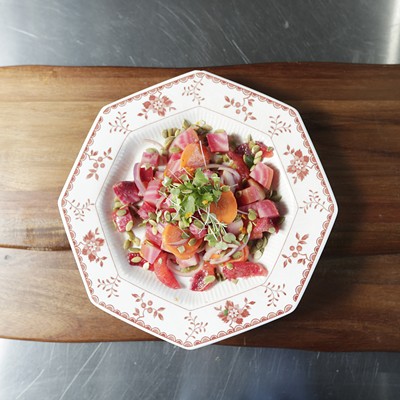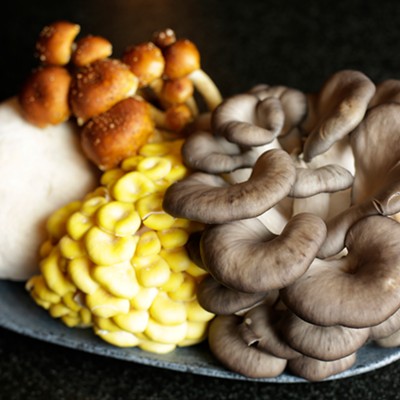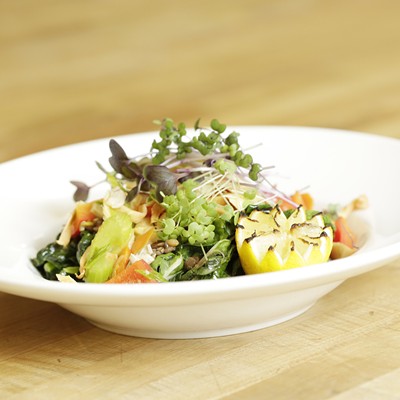FIVE THINGS YOU NEED TO EAT ...and they're all grown here in the Inland Northwest.
Given the opportunity to see better, to delay or prevent Alzheimer’s, coronary disease or diabetes… would you take it? Diet is key to staying healthy and keeping chronic diseases at bay, so InHealth NW challenged me to choose five foods we should be eating.
As a dietitian, I set out to find high-fiber, vitamin-rich, protein-packed, inexpensive foods that are also interesting to the palate. Those are high expectations. Here’s my list of amazing foods that grow right here in the Inland Northwest:
1. Lentils are definitely inexpensive, high in fiber and protein-rich. Legumes also aid in controlling cholesterol and blood pressure. Did you know the Palouse is the most important lentil-producing region in the United States? Pullman calls itself the “Lentil Capital of the World” and even has a yearly festival to celebrate. Interestingly enough, lentil crops aren’t particularly profitable for farmers but help to prepare and protect the soil for winter wheat crops. These helpful little legumes also offer great nutritional benefits for you. So stimulate the local economy and experiment with the fabulous, quick-cooking, versatile lentil. Available in yellow, red-orange, green, brown and black for about a dollar a pound.
2. Americans excel at choosing enriched white flour, robbing themselves of the nutty texture, color, flavor and fiber of other options. Including whole grains in your diet goes beyond the need for fiber, though. Whole grains show promise in fighting breast cancer and lowering blood sugar. Whole grains, or foods made from them, contain all the essential parts and naturally occurring nutrients of the entire grain seed. If the grain has been processed (e.g., cracked, crushed, rolled or cooked), the food product should deliver approximately the same rich balance of nutrients that are found in the original grain seed. Refined grains may have some nutrients replaced, but not all. Remember to not limit yourself to choosing whole-wheat products. Explore other grains like amaranth, quinoa, buckwheat, oats, bulgar, teff, rye and even wild rice.
3. Quillisascut Farm School in Rice, Wash., s-t-r-e-t-c-h-e-d my brain last summer when I was sent to the garden to make a salad. Romaine and iceberg lettuce pale in comparison to the wondrous variety of greens such as arugula, chicory, collards, dandelion, kale, mustard, spinach and Swiss chard. These leafy greens are jam-packed with vitamins A, C and K, folate, potassium, magnesium and iron. Alexa Wilson, executive chef at Wild Sage, shared her favorite salad made with beet greens in our July 2008 issue (you can find it at www.inhealthnw.com). Try these greens raw or lightly cooked. Use in salads or stir-fry. Mix and match. Ask the local produce vendor to let you taste them; your palate will explode at the variety!
4. Apples are the second-most commonly eaten fruit (after bananas). In Greek mythology, apples were associated with the healing god Apollo, perhaps the source for the modern-day motto “an apple a day keeps the doctor away.” The custom of serving apples at the end of a meal arose because of the favorable effects on digestion attributed to the fruit by the physician Hippocrates. Apples are a good source of soluble fiber, especially pectin, which helps control insulin levels by slowing the release of sugar into your bloodstream. Pectin also helps reduce cholesterol levels.
And apples shine in antioxidant richness. Antioxidants act like fire extinguishers in the human body, combating the “destructive fire” of cancer cells. Varieties and flavors of apples in the Inland Northwest are endless: Granny Smith, Jonathan, Ruby Red and Pink Lady each have a distinct crunch and taste.
5. Squash grows like a weed in Inland Northwest gardens. Abundant winter varieties like butternut, buttercup, kabocha, pumpkin or acorn can all be served in a variety of ways. Roast like a potato, bake as oven fries, smash ’em, mash ’em, or puree them into a soup. Grocery stores now sell peeled, diced butternut squash that’s ready to go into the oven, a stir-fry or a soup. Every half-cup has 5 grams of fiber and plenty of vitamins A and C. (Vitamin A is important for vision, bone growth and reproduction.) Our family favorite is Butternut Squash Soup served over cheese raviolis, with a molasses drizzle. One serving of this recipe gives you three days’ worth of vitamin A and meets your daily vitamin C needs. Enjoy!
BUTTERNUT SQUASH SOUP
2 Tablespoons butter
1 small onion, chopped
1 stalk celery, chopped
1 medium carrot, chopped
2 medium potatoes, cubed
10 oz. butternut squash, peeled, seeded and cubed
32 oz. chicken broth
Salt and pepper to taste
Melt butter in a large pot, and sauté onion, celery, carrot and squash for 5 minutes or until lightly browned. Pour in enough chicken broth to cover the vegetables. Bring to a boil. Reduce heat to low, cover pot and simmer 40 minutes or until vegetables are tender. Transfer the soup to a blender, and blend until smooth. Return to pot, and mix in any remaining chicken broth. Salt and pepper to taste. Serves 4.
Nutrition Facts: 228 calories, 7g fat, 34g carbohydrate, 8g protein, 6g fiber




















